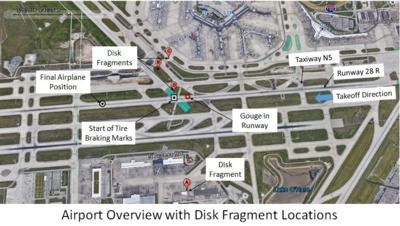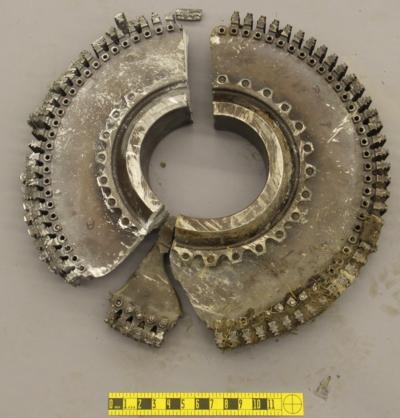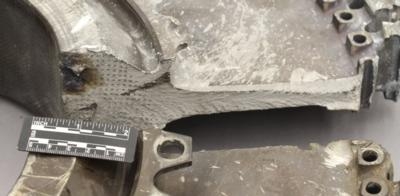Occurred During Takeoff Roll Of American Airlines 767-300 Departing Chicago
As part of its ongoing investigation of an Oct. 28, 2016, uncontained engine failure on American Airlines flight 383, the NTSB issued an investigative update Friday.

The uncontained failure of a GE CF6-80C2B6 engine occurred on a Boeing 767-300 (N345AN) during the take-off roll at Chicago O'Hare International Airport. An emergency evacuation of the 161 passengers and nine crewmembers onboard was conducted.
Initial findings include the following:
According to witness statements from airport personnel, video evidence, flight data recorder (FDR) data and GPS data, the accident flight started its takeoff roll on runway 28R at the intersection with taxiway N5.
The airplane experienced an uncontained failure of the right engine about 6,550 feet from runway 28R threshold, and came to a full stop about 9,225 feet from runway 28R threshold.
Preliminary FDR data show that the right engine failure occurred at an airspeed of about 128 knots with the engine operating at takeoff power.
Approximately two seconds after the engine failure, at an airspeed of about 134 knots, the left and right engine throttle lever angles decreased rapidly. Coincident with the throttle movement, brake pressure rose in a manner consistent with maximum autobrake application; the auto speedbrakes were extended.
The aircraft rapidly decelerated, coming to a stop about 25 seconds after the throttle reduction. As a result of the uncontained engine failure, a fuel leak resulted in a pool fire under the right wing. Airport Rescue and Fire Fighting personnel began applying foam within 2 minutes 51 seconds of being notified of the emergency.
The right engine stage 2 high pressure turbine disk fractured into at least 4 pieces (locations A, B, C, and D in image above). One piece went through the inboard section of the right wing, over the fuselage and into a UPS warehouse facility (location A).

The majority of the stage 2 disk was recovered and sent to the NTSB laboratory in Washington, DC for examination. One of the fractures exhibited features consistent with fatigue cracking initiating at an internal inclusion near the forward side of the hub’s inner bore.
Engine and wing debris were found in the area around the gouge mark on the runway.
3-D imaging of the damage to the right wing has been completed.
All members of the cabin crew has been interviewed.
The disk had 10,984 cycles and had a life limit of 15,000 cycles. Review of the engine maintenance and manufacturing records and processes are ongoing.
Daily progress meetings are being held and the final documentation and examination of the airplane and engine continues in Chicago; the on-scene team plans to finish work by this weekend.

NTSB Senior Air Safety Investigator Lorenda Ward, the Investigator-in-Charge, is leading a team with expertise in the areas of airworthiness, powerplants, structures, survival factors, maintenance records, flight recorders and metallurgy. The flight data recorder and the cockpit voice recorder were transported to the NTSB Recorder Laboratory where the information from each was downloaded.
Parties to the investigation include the Federal Aviation Administration, American Airlines, Allied Pilots Association, The Boeing Company, General Electric Engines, the Transport Workers Union of America and the Association of Professional Flight Attendants.
Ongoing metallurgical examinations of the disk will focus on detailed characterization of the inclusion and the fracture surfaces.
The accident docket, containing factual group reports and other investigation-related material, will be opened at a future date. Additional information will be released as warranted.
(Images provided with NTSB news release)
 ANN's Daily Aero-Term (04.20.24): Light Gun
ANN's Daily Aero-Term (04.20.24): Light Gun Aero-News: Quote of the Day (04.20.24)
Aero-News: Quote of the Day (04.20.24) ANN's Daily Aero-Linx (04.21.24)
ANN's Daily Aero-Linx (04.21.24) Aero-News: Quote of the Day (04.21.24)
Aero-News: Quote of the Day (04.21.24) ANN's Daily Aero-Term (04.21.24): Aircraft Conflict
ANN's Daily Aero-Term (04.21.24): Aircraft Conflict





